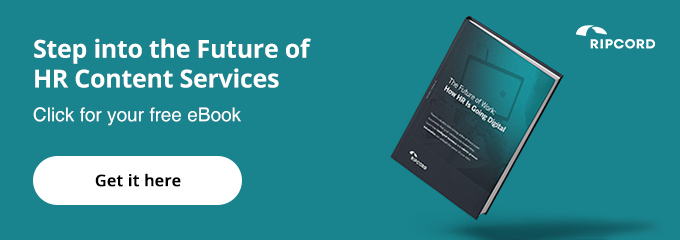
Digital Transformation in HR: Three Challenges and How to Address Them
Keeping records of employee information, hirings, attrition, and terminations is not a task for the faint of heart. It's a time-consuming, arduous undertaking. Nearly half of small business owners spend a full workday each week taking care of it and other HR-related matters, according to a recent study by human resources outsourcing firm Oasis. For larger firms, whole teams of HR experts spend hours each week on these same tasks.
At Ripcord, we believe it's well past time to stop wasting time. Below, we discuss the three challenges faced by human resources personnel -- and share recommendations around how you can stop getting those headaches.
#1 Compliance
Businesses of every size have to worry about complying with local, state, and federal laws. On the federal side alone, there's the U.S. Equal Employment Opportunity Commission, the Occupational Safety and Health Administration, and the U.S. Office of Personnel Management, all of which necessitate the following of numerous rules and the filing of various lengthy documents.
The Age Discrimination in Employment Act and the the Fair Labor Standards Act mandate that employers keep employee records for a minimum of three years, and the Health Insurance Portability and Accountability Act requires the designation at the employer organization of a 'privacy official,' as well as the adoption of various privacy-related procedures.
All this equals paperwork. A lot of it. Given all of the shortcomings of paper (it quickly becomes voluminous and expensive to store, sort, and ship, and it's highly insecure), it's becoming increasingly untenable to rely on paper for documentation, particularly in the HR space.
Digitizing employee records with a platform such as Ripcord's Canopy means doing away with warehouse spaces full of banker's boxes through which no one could begin to search efficiently. Using Canopy enables HR to locate a specific, granular data point from among thousands of files, with a sub-second database search. It means, in short, relief for human resources departments everywhere.
#2 Different Content Types and Information Structures
In a typical workweek, HR personnel are called upon to handle and work with a variety of data types. These may range from drafting an updated employee handbook to explaining a non-disclosure agreement to a team member, to making an audio recording of a meeting for legal reasons. With such varied content — and so much of it — HR personnel need a digital data management system that can keep up with their workflow.
Ripcord's Canopy is a robust, secure platform capable not only of storing and classifying both structured and unstructured files but also "learning" about the needs of the company to the extent that it can even engage in analysis of the stored information, significantly increasing organizational efficiency.
#3 Legacy Specialist HR Systems
Many human resources professionals make use of software intended to make their jobs a bit less stressful. These can include human capital management (HCM) software, such as Oracle HCM Cloud, and enterprise resource planning (ERP) platforms, such as Workday. The costs of these systems are far from insignificant. What's more, they require hours of training before employees can get the most out of them.
After all that investment, few companies already using these solutions would be willing to toss them by the wayside. With Canopy, there's no need to do so. Ripcord's platform seamlessly integrates with such specialist HR software, giving users better control of their digitized data.
Ripcord is on a mission: to digitize Earth, one industry at a time. Let's get back to the high-level work we love, and let automation take care of the rest. Step into the future of HR content services with Ripcord today.
/Ripcord%20Logo%20-%20Color%2011.png?width=2000&height=620&name=Ripcord%20Logo%20-%20Color%2011.png)


%20What%20It%20Is%20and%20Why%20It%20Matters%20-%20Ripcord.jpg?quality=high&width=596&name=Unlocking%20the%20Power%20of%20Robotic%20Process%20Automation%20(RPA)%20What%20It%20Is%20and%20Why%20It%20Matters%20-%20Ripcord.jpg)
.jpg?quality=high&width=596&name=Revolutionizing%20P%26C%20Insurance%20The%20Power%20of%20Intelligent%20Document%20Processing%20and%20AI%20-%20Ripcord%20(1).jpg)
.png?quality=high&width=596&name=Five%20Best%20Practices%20for%20RPA%20Implementation%20-%20Ripcord%20(1).png)